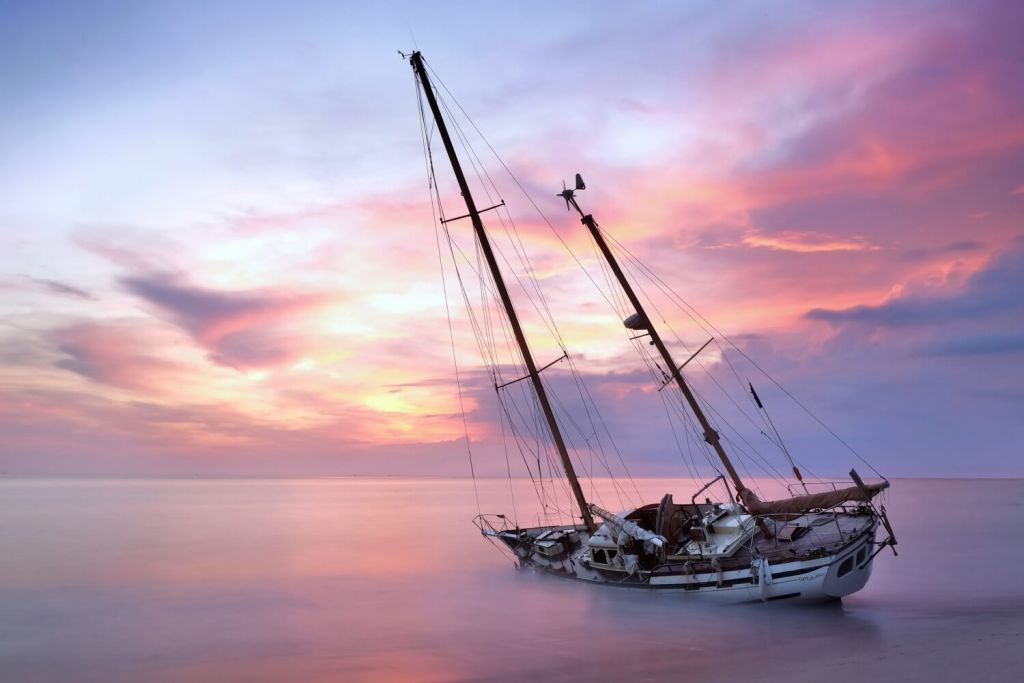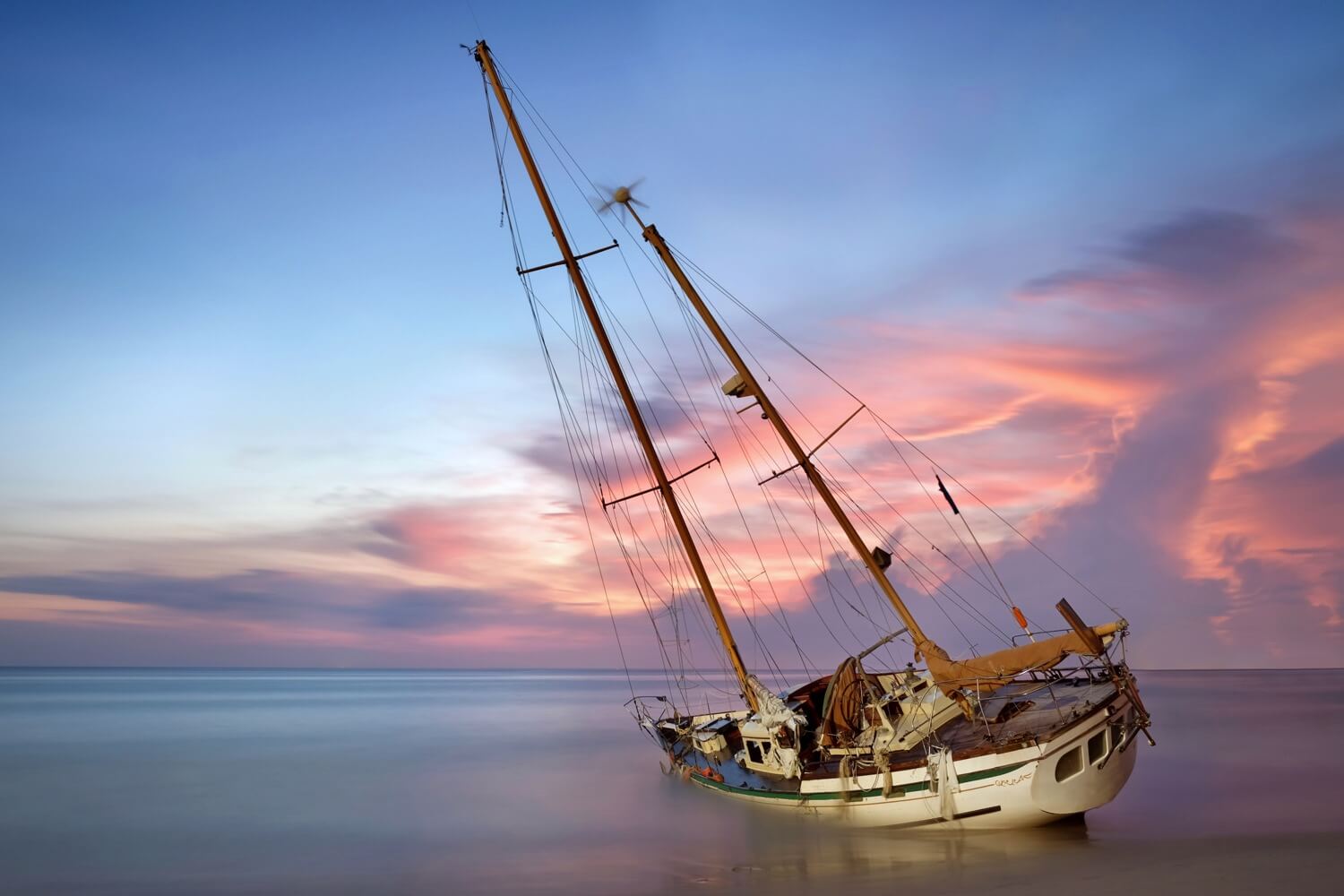The Minimum Water Depth for Different Types of Boats
Not knowing your boat's draft can have disastrous consequences. This article lists the draft of various boat types. Read it so you don't find yourself stuck in the mud.
Here's the average draft for common boat types:
- Sailboat cruisers - 4 to 7 feet
- Daysailers - 3 to 5 feet
- Catamarans - 2 to 4 feet
- Motor yacht cruisers - 1 to 4 feet
- Dinghy - a few inches
- Trawlers - 8 feet and up
I need to point out that those numbers are relative - ballpark figures. So let me tell you a bit more about them - you might learn a trick or two that will help you stay afloat.

What Is Draft And Why Is It So Super Important?
For those who haven't encountered this term before - draft (or draught) is the distance between the water surface and the deepest point of the boat underwater. So practically speaking, the value of draft is equal to the minimum water depth required for smooth floating. Go any shallower and you will scrape your boat's bottom.
You absolutely must know the draft of any boat you are driving. While scraping some paint off of your car when you misestimate the distance between you and the lamp post will mostly just cost you the repair fee, 'getting in touch' with the sea bed can cost you much more than that.
Your life even.
Ok, that might have been a bit too dramatic.
But depending on whether the sea bed consists of sand, seaweed or rocks, you can either get beached and become immobile, or your propellers might get tangled in whatever is down there, or you can pierce a hole into your boat.
Boat repairs are expensive, even if you got lucky and just scraped the surface. Getting towed to a safe depth can also be expensive and dangerous to your boat. Simply put, not respecting your draft can put a dent in your pocket and turn a nice cruise into a logistical nightmare.
Therefore, whatever boat you get on, know your draft! You can find this number often in the cockpit. If not, consult the boat's manual or the internet at the very least. I usually double that value and never go into places where the plotter shows a lower number. If I, by any chance, don't have a depth measuring device and am operating on just a map, I am even more careful.
To tell you the truth, I start to sweat nervously once the depth goes into single digits.
Now let's get back to the categories mentioned above.
Sailboat Cruisers - Draft of 4 to 7 Feet
This is the kind of boat you will most likely find yourself on if you go on your typical cruise. A classical sailboat, some 30 to 50 feet long. Its draft will probably be between 4 and 7 feet. The reason this category has a rather deep draft is because of its keel. While the keel is a necessary component of a sailboat and makes your life much easier and your boat much more stable, the price you pay is that there is a long piece of steel below the boat's belly. A piece of steel you gotta be mindful of when you get close to the shore.
To give you a specific example: the Beneteau Oceanis 281, which is 28.5 ft long and has 4 ft of draft. Staying with the same line but moving up to a larger size, the Beneteau Oceanis 45 has 5.9 ft of draft. Give or take a few inches, depending on the specific year's model.
But by no means take these numbers for granted. See this as a rough guide and check for the specific draft of the boat you are on.
Daysailers - Draft of 3 to 5 Feet
Daysailer's draft tend to be smaller than that of cruisers because daysailers are smaller, usually 14 to 20 ft long.
The 14 ft long Hunter 140 has a draft of 3 feet, the Ultimate 20 has a draft of 5 feet. The good thing about these smaller boats is that they often have a retractable keel. So while sailing, you enjoy all the stabilizing benefits of having a keel, and when it is time to dock, you pull the keel up and the draft reduces, from several feet to several inches.

Catamarans - Draft of 2 to 4 Feet
To compare apples to apples, we are talking about similarly sized cats as the aforementioned cruisers here. The reason the draft is smaller than that of cruisers is that since cats are more stable by nature, and also because they have two keels, they can afford to have them smaller. Also, because of their two hulls and the subsequent higher buoyancy, they tend to cut into the water less.
This generally makes it possible to voyage into shallower waters with them than with a monohull of the same size. But as mentioned before, make sure you know the specific draft of your boat before untying the ropes that lock your boat to the pier. Apologies for repeating myself but I just can't stress that enough. Especially since on a cat, you will be scraping two bottoms, not just one.
Motor Yacht Cruisers - 1 to 4 Feet
The reason you are seeing an even lower number here is that motor yachts don't have keels. They don't technically need them. If I were you I would be extra careful with these though. Scraping paint off of your keel is safer than piercing a hole directly through your hull.
Yea, yea, I know I am a bit too dramatic. Better safe than sorry though.
To provide an example, the Jeanneau Prestige 46, a nearly 48 feet long boat has a draft of just a bit over 3 feet. To remind you, a similarly sized Beneteau Oceanis 45 has a draft of 5.9 ft.
Dinghy - Just a Few Inches of Draft
A dinghy is your best friend when it comes to getting around shallow spots. That's why when you anchor in a nice bay for the night, you drop your dinghy on water and use that to get to the shore. Not only is their draft just a few inches deep, they are light and their bottoms are made to withstand all kinds of abuse. So driving your dinghy full speed onto a beach is still relatively safe.
Giving you a specific figure here would make little sense. Since dinghies are small, their draft is influenced by whether you had a big breakfast before getting on one, or a small one.
Trawlers - Lots And Lots of Feet
The reason I even mention these is not because I expect you to be a captain of a huge fishing trawler someday. But these boats generally serve as a good pointer of where you can go with your average boat, even without looking at the instruments. Since even the smaller trawlers tend to have a draft of around 8 feet, you can be sure that if you go where they do, you are in the safe zone. On several occasions, they provided peace of mind when I found myself wanting to sail in between two shallow points or if I was not sure whether such and such bay has enough depth.
In case by a trawler you mean a normal-sized recreational boat, which is similar to a classic motor yacht, but such that doesn't plane, (and thus is slower) these have a larger draft relative to their similarly sized motor yacht counterparts. Usually not as large as a similarly sized sailboat, though that can happen too. This is because they are not made for speed but rather for comfortable onboard living, which shows in the design.
As an example, a 42 ft Treworgy Trawler has a draft of 4 ft and 9 inches - compare that to the aforementioned examples.
So What To Do With All This Info?
It is quite simple. As mentioned, before you set sail, make sure you know your draft. The value is usually written down in a place where you can see the number when standing behind the helm, but if not, find out where it is (or what it is).
Add a value you are comfortable with to provide some safety cushion and then compare it with what your depth meter tells you. Know that the depth is usually measured from the bottom of the hull, not the deepest point of the keel. So if you are on a sailboat, add the keel size too.
How do you know how deep your keel is?
If you're unsure how deep your keel runs, I recommend checking out our sailboat keel depth resource. which will show you a detailed table of average keel depths based on extensive research.This information is not available anywhere else on the internet.
If you don't have a depth meter, consult your maps. They likely won't be as detailed but they will give you the necessary info.
I also recommend getting a depth meter. There are cheap options to be had and they provide valuable information. Here's my recommendation for the best value depth meter on Amazon:
And when you have all this added up and compared, be careful. Try to be reasonable when making a judgement on where to go. I have seen too many damaged boats to say otherwise. Don't risk touching the seabed with your boat. It is very rarely worth the potential damage.
Fair winds!
Did you find the answer to your specific question?
👍 13 👎 7
Leave a comment